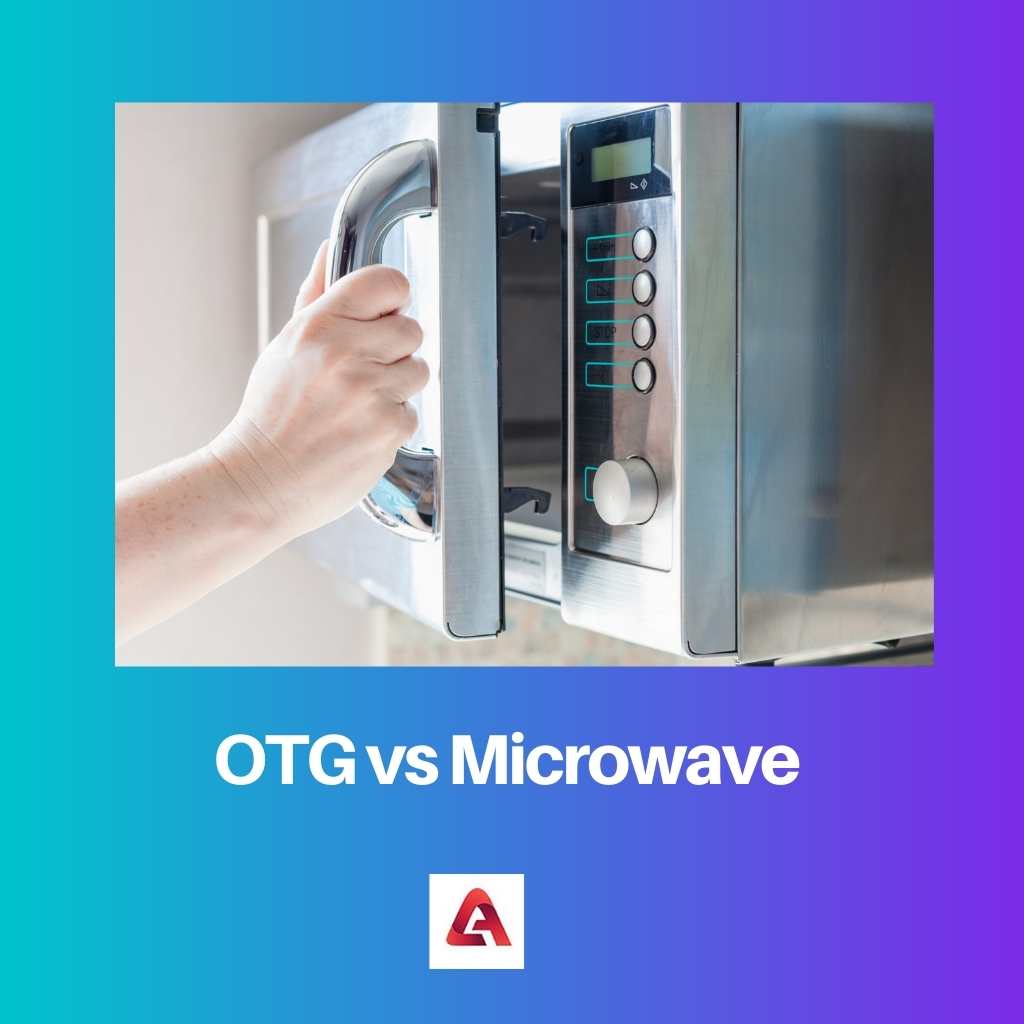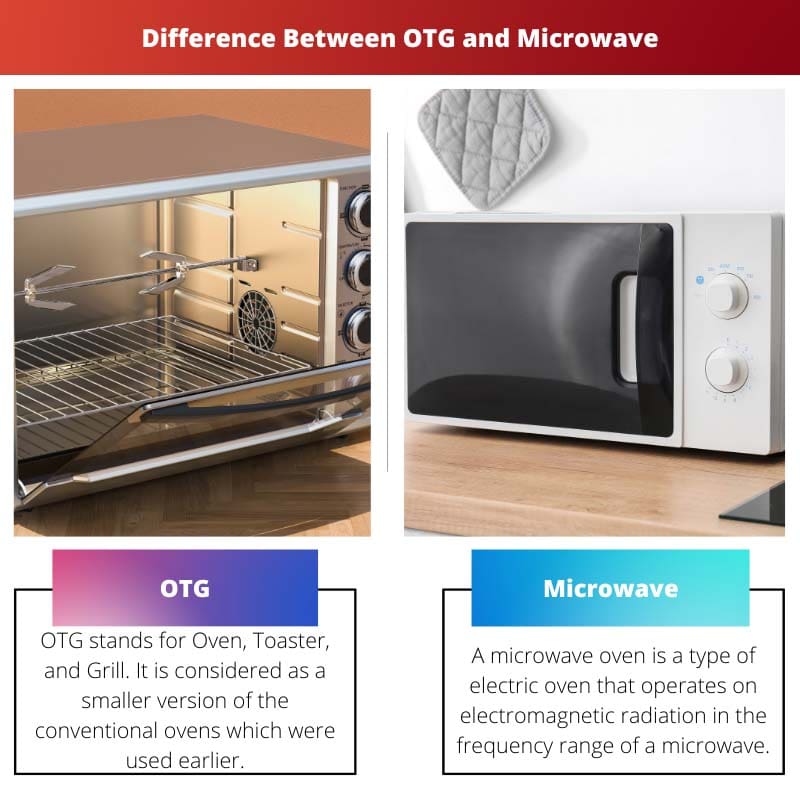The introduction of ovens in the food industry or household kitchens prevented the risk of burns and maximized the efficiency of heating and other cooking techniques. Two main types of ovens are most popular in the appliance industry.
They are OTG and Microwave.
Key Takeaways
- An OTG (Oven, Toaster, and Grill) is a versatile appliance for baking, grilling, and toasting, while a microwave is primarily used for heating and cooking food quickly.
- Microwaves cook food faster than OTGs, but OTGs offer more precise temperature control and even heat distribution.
- OTGs are better suited for baking and grilling, while microwaves excel in heating and defrosting food items.
OTG vs Microwave
An OTG is a versatile baking, grilling, and toasting appliance. It can be used for various cooking tasks, such as roasting, baking, and toasting. A microwave uses microwaves or electromagnetic waves to warm food fast and efficiently. It is ideal for reheating leftovers, cooking, and defrosting food.

The mechanism of heating in OTG has electrical coils. The pre-heat time in OTG is comparatively more and takes about 15 to 20 minutes.
Thus the total cooking time is extended in OTG. The main aim of using an OTG is that it has a larger capacity and can perform toasting, grilling, and baking within a lightweight model.
On the other hand, the mechanism of heating in the microwave has electromagnetic waves and radiation which are produced in the frequency range of the microwave. The preheat time in the microwave is comparatively less and takes about 4 to 5 minutes. So the total cooking is shortened with the help of the microwave.
The main aim of using a microwave is that it can perform cooking, reheating, or defrosting with uniformity.
Comparison Table
| Parameters of Comparison | OTG | Microwave |
|---|---|---|
| Heating procedure | OTG uses electric coils for heating | Microwave uses electromagnetic waves for heating which allows the particles of the food to oscillate |
| Heating time | Approximately 15 minutes is required for heating | Approximately five minutes is required for heating |
| Heat distribution | Less uniformly and even | More uniformly and even throughout |
| Availability of auto-cook | The auto-cook functionality is not available in OTG | The auto-cook functionality is available in the microwave |
| Weight | Lighter and easier to move or transport | Heavier and difficult to transport or shift quite |
What is OTG?
OTG stands for Oven, Toaster, and Grill. It is considered as a smaller version of the conventional ovens which were used earlier.
The operating type in OTG is the usage of heated coils to cook meals. The oven does not require much setting up before the cooking procedure.
The temperature in the OTG is controlled by a thermostat. The control of the temperature ensures that the food is cooked properly and heated uniformly.
The food which is cooked in OTG absorbs the heat which is radiated by the coils. The presence of a fan in OTG allows the distribution of the heat in the entire chamber.
However, the primary dispensation of the heat is directly below the coil.
Ideally, OTG is used for grilling baking, and even toasting. It cannot perform functions like deep freezing or cooking.
Food batches that are large in quantity can be effectively cooked with an OTG as the capacity is quite large. It provides up to 60 liters of capacity.
Even with a large capacity, it is quite lightweight and portable which helps in the easy transportation and installation of the product.
The preheating time in OTG takes around 15 to 20 minutes. The tracking of temperature and time is not quite easy with OTG with the conventional knobs.
The usage of energy is also comparatively more than other types of ovens. However, OTG caters to an affordable section of the audience in the market of ovens.

What is Microwave?
A microwave oven is a type of electric oven that operates on electromagnetic radiation in the frequency range of a microwave. The operation in the chamber of the microwave occurs by inducing the polar molecules of the food and causing rotation.
This in turn produces thermal energy which is also termed dielectric heating. During cooking food in a microwave, the water molecules of the food are heated.
There is a presence of a rotating plate which ensures an even and uniform cook of the food in the chamber. The efficiency of microwaves is the fastest in the oven industry.
The development of the microwave was mainly done by an American engineer, Percy Spencer. The first microwave was known as Radarange and was sold in the year 1946.
Ideally, the microwave is used not only for baking grilling, and toasting but also for cooking reheating, and de-freezing. It solves the problem of food turning lumpy or easily burn if the food is heated in conventional pans.
The microwave will not caramelize food or directly make them brown as certain necessary temperatures need to be attained before producing the reaction.
The role of the microwave in professional cooking is quite restricted and limited as the boiling temperature ranges provided by a microwave oven are not enough to produce chemical reactions that are flavorful for browning, frying or baking at a high temperature. The high temperatures in the microwave can also cause superheating or fire on the food.

Main Differences Between OTG and Microwave
- The heating time in OTG is comparatively slower while the heating time in the microwave is faster and quicker.
- OTG is ideal for customers on a tight budget while the microwave is ideal for users who are ready to splurge some extra bucks.
- Metal containers can be used in OTG while metal containers cannot be used in the microwave.
- OTG is ideal for baking roasting and grilling while the microwave is ideal for simple baking and defrosting.
- The capacity of OTG is up to 60 liters while the capacity of microwave is up to 32 liters.

- https://link.springer.com/chapter/10.1007/978-981-16-0594-9_8
- https://ieeexplore.ieee.org/abstract/document/6848677/




